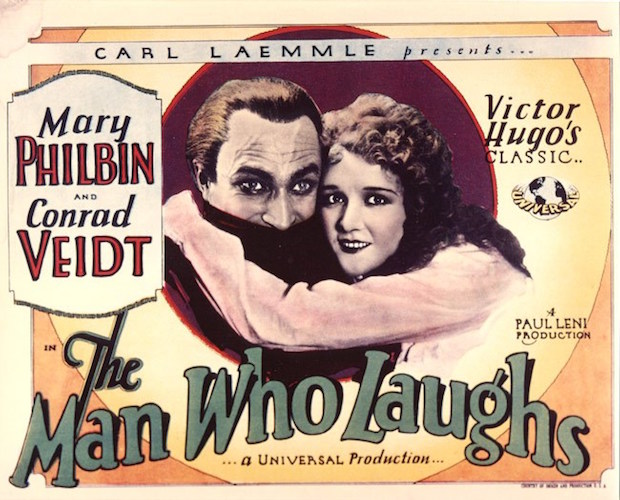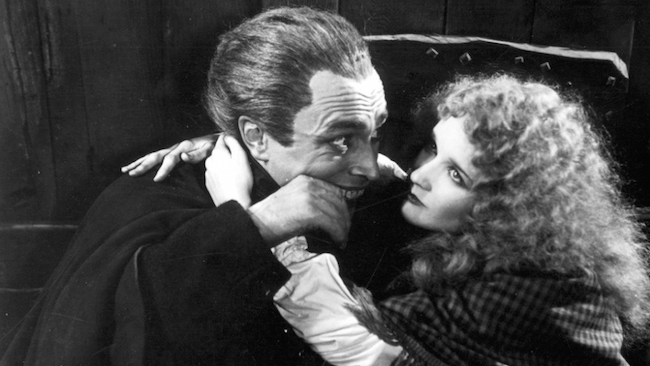Film Preview: “The Man Who Laughs” — A Perfect Fit for the Berklee Silent Film Orchestra
This effort is the most “Hollywood” score the BSFO has created yet, a plush musical carpet for The Man Who Laughs’s emotional high and lows.
The Man Who Laughs, music composed and performed by the Berklee Silent Film Orchestra. Screenings at The Cabot Theater, Beverly, MA, on June 16, the Dreamland Film and Performing Arts Center at the Nantucket Film Festival on June 19, and Martha’s Vineyard Film Center on June 21.

By Tim Jackson
Berklee Silent Film Orchestra’s live performance of its collaborative soundtrack for the 1928 silent film The Man Who Laughs wowed the crowd last Monday night at Coolidge Corner Theater’s Sound of Silents Series. Alison Plante directed what is the orchestra’s 12th score, which opened the San Francisco Silent Film Festival in May. Directed by German Expressionist Paul Leni and based on the Victor Hugo novel, the movie has been called one of the greatest achievements of the late silent film era. The score is the collaborative work of seven composers, each of whom sequentially score and conduct their individual segments. This effort is the most “Hollywood” score the BSFO has created yet, a plush musical carpet for the narrative’s emotional high and lows, nimbly crafted to highlight its sprawling combination of romance, adventure, horror, and history.
The Man Who Laughs had been planned as a Lon Chaney vehicle, the star’s follow-up to 1923’s successful The Hunchback of Notre Dame. When producer Carl Laemmle found that the rights to The Man Who Laughs had not been secured, Chaney went on to star in The Phantom of the Opera. In 1928, production of The Man Who Laughs finally began, its lead role assumed by Conrad Veidt (the Nazi general in Casablanca) as Gwynplaine, with Phantom’s Mary Philbin as the antihero’s blind love interest, Dea.
The story is filled with Hugo’s customary outsized themes: injustice, corrupt and decadent royalty, dark advisors, disfigurement and alienation, rowdy peasants, and, of course, the triumph of love. The story begins with the execution of Gwynplaine’s father by the order of the king—but not before the man sees the face of his only son disfigured into a permanent rictus by Comprachico (child-buying) gypsies. When the gypsies are forced into exile, the boy is abandoned in a raging snowstorm. During his trek he rescues a baby from the arms of its dead mother, eventually coming upon a cabin where he seeks shelter. The owner, a philosophical carnival owner named Ursus who lives with his pet wolf, Homo, raises the boy and the infant. Years later, Gwynplaine makes his living as a showbiz attraction, “The Man Who Laughs,” a top draw on the peasant vaudeville circuit as well as the star of Ursus’s plays (which he claims are “greater than Shakespeare’s”). The rescued infant has grown into the beautiful blind performer, Dea.

A scene with Conrad Veidt and Mary Philbin from “The Man Who Laughs.”
One night, attending a performance, Duchess Josiana, an illegitimate daughter of the king, finds herself attracted Gwynplaine’s grace as well as his deformity. Josiana learns that Gwynplaine’s father was actually a baron. In a quick plot turnaround, her attraction instantly turns to revulsion. Gwynplaine was charismatic as a freak — but he is hideous when seen as a peer. Want more complication? The jester, Barkilphedro, arranges to have Gwynplaine arrested and forced to marry the Duchess, to the delight of the Queen, who sees this as a way to torment the obstreperous Duchess. Gwynplaine rejects his right to a title and the arranged marriage; he delivers a passionate plea for equality in front of a derisive court. In an extended chase finale, he duels his way back to Dea—the one person who truly loves him.
The plot is intricately melodramatic, the characters unusually complex for a silent film. Even the wolf, Homo, has his moment to shine. The performances proffer the physical grace of seasoned stage acting, but eschew the overly emotional style that makes some silent films feel dated to modern audiences. Veidt, his face constrained by a hideous grin, depends on his eyes, forehead, and his body to express the role’s range of emotions. As the sexually liberated, free-thinking Duchess Josiana, Olga Baclanova (“Chickenlady” in Tod Browning’s Freaks) uses her steely gaze and subtle shifts of her body to effortlessly convey the characters’s see-saw between attraction and repulsion. As the twisted court jester Barkilphedro, Brandon Hurst sports an indelibly slimy grimace as he lurks about in dark corridors. Director Leni fills the sets and streets with a striking assortment of odd characters; the frames are stuffed with people and things. The restored print is pristine.
According to Sheldon Mirowitz, the Founding Director of the BSFO, The Man Who Laughs commission was facilitated by Randy Haberkamp of the Academy of Motion Picture Arts and Sciences. He received a significant anonymous donation to chose the restoration of 12 silent films. As a fan of both the restored Man Who Laughs and the BSFO, Haberkamp believed that the film and the group were a perfect fit. He is a wise man. A planned DVD release will include both the BSFO score and music written to accompany the film in the ’20s.
Tim Jackson was an assistant professor of Digital Film and Video for 20 years. His music career in Boston began in the 1970s and includes some 20 groups, recordings, national and international tours, and contributions to film soundtracks. He studied theater and English as an undergraduate, and has also has worked helter skelter as an actor and member of SAG and AFTRA since the 1980s. He has directed three feature documentaries: Chaos and Order: Making American Theater about the American Repertory Theater; Radical Jesters, which profiles the practices of 11 interventionist artists and agit-prop performance groups; When Things Go Wrong: The Robin Lane Story, and the short film The American Gurner. He is a member of the Boston Society of Film Critics. You can read more of his work on his blog.
